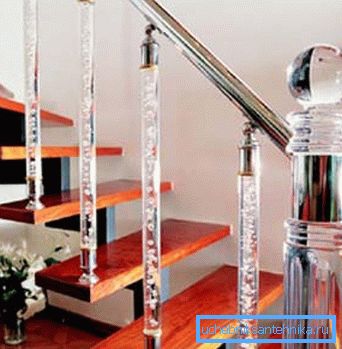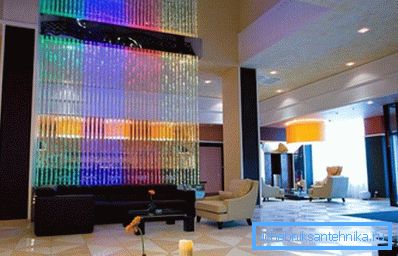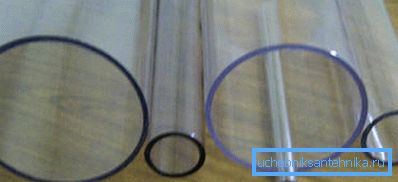Transparent tube: materials and characteristics
For the transportation of fluid from one place to another, you need some kind of capacity and for this, transparent pipes for water are perfectly suited, through the walls of which you can observe such movement. Perhaps the leader of the materials here can be called polycarbonate, which is only 1-2% inferior to glass in optical properties, but it has a low weight and excellent mechanical strength.
But there are other plastics that are suitable for the manufacture of pipes and are used in everyday life and industry, but more on that below, and in addition, you will find a thematic demonstration of the video in this article.

Pipe materials
Polycarbonate
Definition Polycarbonates belong to the group of thermoplastics with the general chemical formula -O-R-O-CO-.

As mentioned above, polycarbonate is much lighter than glass, about 2.5 times, but at the same time it has high mechanical strength (10 times higher than acrylic) and it is these two qualities that became the impetus for popularizing the material, as in everyday life , and in industry.
In addition, such a material was appreciated by installers - such a pipe is very easily processed with carpentry tools - it is drilled, cut, ground, and a self-tapping screw can be screwed in without any problems.
Polycarbonate pipes are fireproof, so in combination with all other qualities such products are of great interest to industrialists, moreover, they have a whole list of other advantages.

- Optical properties at height - the product is transparent;
- Opal tubes and sheets scatter light evenly;
- The density of the material 1.2kg / cm3, low weight;
- In mechanical terms - impact resistant (very difficult to break);
- For natural conditions withstands a wide range of temperature drops;
- It has excellent dielectric properties;
- In manufacturing, it is provided with additives for resistance to ultraviolet radiation and antipyrites for fire safety;
- Resistance to aggressive chemical environment (detergents, solvents, acids) and inertness to food (dairy products, alcohol, drinking water);
- Polycarbonate pipe with a wall of 1.5 mm withstands high internal pressure: diameter 50 mm - 32 kg / cm2; diameter of 38 mm - 40 kg / cm2; with a diameter of 25 mm - 80kg / cm2.
| Different properties | Technique | Value | |
| Physical | 600-3 | 600-5 | |
| Melt flow rate (300? C / 1,2 kg), g / 10 minutes | ISO R1183 | 3 | five |
| Density, kg / m3 | ASTM D-955 | 1200 | 1200 |
| Shrinkage% | ISO 1133 | 0.5-0.7 | 0.5-0.7 |
| Optical | |||
| Light transmission% | ASTM D1003 | 86-90 | 86-90 |
| Temperature | |||
| Pace. Thermal deformation annealed (load 0.45 MPa), ° C | ISO 75 | 146 | 145 |
| Pace. Thermal deformation annealed (load 1.82 MPa), ° С | ISO 75 | 143 | 142 |
| Pace. Thermal deformation unannealed (load 1.82 MPa), ° С | ISO 75 | 126 | 126 |
| Pace. Vika softening (50 ° С / h), ° С | ISO 306B | 150 | 150 |
| Mechanical | |||
| Ultimate tensile strength, MPa | ISO R527 | 60 | 60 |
| Yield strength at break, MPa | ISO R527 | 56 | 56 |
| Relative elongation at stretching,% | ISO R527 | 6 | 6 |
| Relative elongation at break,% | ISO R527 | 90 | 90 |
| MPa Yield Strength Module | ISO R527 | 2300 | 2300 |
| Flexural Strength MPa | ISO 178 | 94 | 94 |
| Flexibility module, MPa | ISO 178 | 2300 | 2300 |
| Izod impact strength with KJ / m notch2 (23 ° C) | ISO R180 | 850 | 800 |
| Izod impact strength without cut KJ / m2 (23 ° C) | ISO R180 | No break | No break |
| Electric | |||
| Glow-wire test 2.0mm 5 sec. WITH | IEC 695-2-1 | 850 | 850 |
| Pace. ball pushing, ° С | IEC 598-1 | >125 | >125 |
| CompTracking Index (2.0 mm), V | IEC 112 | 225 | 225 |
| Flammability Class (1) | |||
| 1.6mm | UL-94 | HB | HB |
| 3.2mm | UL-94 | HB | HB |
CALBRE 603 polycarbonate table with UV stabilizer
Explanation. The sign (1) denotes the value of the speed with which the flame propagates and such instruction does not apply to other materials, but only to CALIBRE 603.
Plexiglass

Organic glass or another word - polymethylmethacryl (PMMA), also belongs to the category of thermoplastics, and its popularity is more related to the unique optical properties - the gloss of the surface and there is no any distortion of the image.
Such an acrylic pipe can have not only a smooth, but also a glossy or velvety surface, and in combination with high impact resistance, it is in demand in the industry for various equipment. In addition, they are very well treatable - drilling and cutting with a conventional tool.
If there is a need to bend such a pipe with your own hands, then it is heated to a temperature of 160? C, and the connection is made with screws. Inside they have a matte shade, while outside they have a brilliant polish. Such pipes are made in two ways - this is extrusion and casting.
Plastic

Plastic pipe for sewage is incredibly popular - it has practically supplanted steel and cast iron in the construction market, although some competition for wastewater disposal is asbestos-cement, but this opposition is very weak. The fact is that metal and chrysolite cement are most often used for pressure pipes, to which sewerage can relate only in some cases, for example, in the pulp and processing industry.
The ease of manufacture, low weight and low price of polyvinyl chloride, along with the ease of installation, provide such pipes with a huge niche in the plumbing installation, both at the household and at the industrial level. Another advantage of PVC products are fittings of any configuration, allowing you to make turns at different angles, move to another plane and change the diameter.
Conclusion
At the household level, transparent pipes are used extremely rarely, and for the most part as decorative ornaments or any household appliances. If we talk about plumbing, here preference is given to steel, PVC, polypropylene (ecoplast) and metal-laminated plastics - sewage and water pipes are fully provided with such materials.